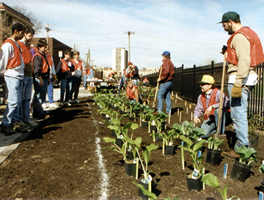 |
Plantings
may or may not be part of the transportation project selected by the Twin
Cities Academy students, but these young people participating in the Stevens
Square landscaping partnership also learned a lot from Scott Bradley (kneeling),
as well as Rick Bonlender (standing, far right). Photo by Kevin Walker
|
Middle school students don’t normally talk about ‘context sensitive design’
and ‘traffic calming.’ However, eighth graders at the Twin Cities Academy charter
school in St. Paul have developed this interest thanks to last week’s school
visit by Mn/DOT principal landscape architect Scott Bradley.
Bradley visited as part of an Eco Education Urban Stewards Project, a speaker’s
bureau that works with schools to educate students on environmental issues.
"The program tries to instill an inquisitive approach to looking at how
we fit into our environment," Bradley said. "Students were asked to
pick a project that they could investigate and possibly do something about."
They eventually chose a transportation project because "they are concerned
about the speed of the traffic on Randolph Avenue just outside their school,"
he said.
Besides showing and discussing photos from Mn/DOT projects and highlighting
scientific principles involved in each case, Bradley promoted the big picture.
"I talked about the larger picture of transportation statewide,"
he explained. "I talked about trying to balance safety with mobility, environmental
concerns with community needs, to come up with a context-sensitive design. We
focused on projects where the balance of these factors could be complex."
Behavioral science principles got most of the students’ attention, so Bradley
discussed ways to influence drivers’ behavior.
"We looked at how you can make a road LOOK narrower without actually MAKING
it narrower," he said, such as use of medians, contrasting pavement and
shoulder colors, location of edge plantings and banners.
By the end of the day, Bradley knew he had connected. "The students had
become particularly interested in traffic calming ideas they could investigate
on Randolph Avenue," he said, "and in how physics and chemistry were
connected to everything. I wasn’t anticipating that their questions would be
so sophisticated."
Generating enthusiasm for math, science, technology and transportation is one
of Mn/DOT’s goals in education outreach programs—in both employee-initiated
efforts and in management-sponsored initiatives.
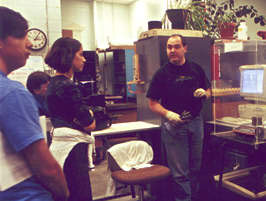 |
|
Tours
of Mn/DOT facilities form an important part of several Mn/DOT education
outreach programs, including Aeronautics, Seeds, TRAC and Explorer. These
students tour the Materials Laboratory in Maplewood. Photo by Craig
Wilkins
|
The ‘power of one’
Employee-initiated programs include one-on-one reading and math programs for
grade and high school students. District 4 Project Management Engineer Lori
Vanderhider began such a math-tutoring program when she was a graduate engineer
in District 3.
Her coworkers’ strong interest in her efforts led her to obtain management
approval for volunteers to tutor during the work day when schools were in session.
Nineteen volunteers, or 15 percent of Brainerd’s in-house employees, she said,
tutored weekly during the 1994-95 school year.
Volunteers used flex time, vacation time, or lunch hours—or made time up—to
tutor, judge writing contests and a toothpick bridge building contest, and pair
with students for "shadowing," she said.
Vanderhider described how her efforts helped one young boy who was flunking
math.
"The teacher had said there was no way he’d pass math at the end of the
school year, but we kept plugging away," she said. "He asked me to
give him his final test, and he did great—he got 100 percent correct. His classmates
practically applauded. I left the school in tears that day. Sometimes it just
takes someone believing in you."
Tutoring children can lead to helping their parents as well, Vanderhider said.
"One mother asked me for tutoring for herself," Vanderhider said.
"Tests showed that she could be good in engineering. Now, she’s a civil
engineering tech who works for the county. I have a lot of respect for her;
she was a welfare mom with two kids, and she’d drive in for classes in her old
beater of a car. She just wouldn’t give up."
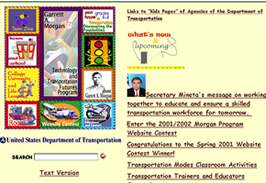 |
|
This
colorful Web site by the US DOT features many useful links for people
who want to learn about aircraft and flying, but the only education link
listed leads back to Mn/DOT Aeronautics’ site.
|
Using a ‘hands-on’ approach for aviation education
Mn/DOT Aeronautics offers several programs to encourage students’ interests
in math, science, technology and aviation industry careers. This includes a
speakers bureau and tours of aviation facilities for schools and groups such
as the Boy Scouts and Girl Scouts.
"We take several large containers full of plane parts to the schools,"
said Janese Buzzell, aviation education manager. "We’ll show the kids what
the part is and how it helps make the aircraft work. Kids just love to be able
to touch parts of the aircraft like the brake, windshield, or a piece of the
wing section."
Aeronautics’ Web site, which is "the only curriculum link from the Federal
DOT Web site," Buzzell said, provides an easy outlet for reaching school
teachers and students. The Aeronautics Web site features links to:
-
Summer Aviation Career Education Camps for grades 10-12;
-
International aviation art contests; and
-
Downloadable school curricula developed by Aeronautics’ staff, the Federal
Aviation Administration, and teachers who’ve attended Mn/DOT’s yearly Transportation
Education Academy.
"We supply over 1,000 teachers a year with our aviation curricula and
materials," Buzzell said. "We also visit about three to five schools
a month on average."
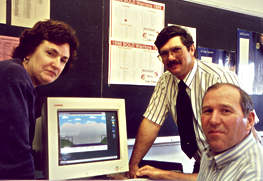 |
|
Teacher
evaluations are an important part of any education outreach effort, which
is why Sue Stein (left) and former District 8 TRAC coordinator Rob Mortensen
(center, back) visit with this teacher (right, front) as he evaluates
the interactive computer program on the computer screen. Staff photo
|
Mn/DOT Engineering Explorer
Mn/DOT also offers Explorer
through the Boy Scouts and Girl Scouts.
"The Mn/DOT Engineering Explorer program is a co-educational scouting
activity that focuses on transportation-related careers," said Emeric Pratt,
outreach program coordinator. "We don’t formally teach them, but we do
bring activities into a classroom setting with students and their parents. We
were also able to offer some summer internship positions last year. We now have
some interns returning from previous years."
Pratt added that the parents benefited as much as the students. "The parents
ask more questions than the kids, and keep saying, ‘We didn’t have anything
like this when we were kids,’" he said.
TRAC can lead to transportation-related careers
Thirty-eight Minnesota middle schools and high schools participate in TRAC,
a program the American Association of State Highway and Transportation Officials
sponsors, which takes a different approach.
"TRAC is geared towards women and minority students," explained Pratt.
"It came about because AASHTO was looking at the future of transportation
and the need for women and minorities to enter civil engineering. They developed
this program in which transportation employees go into classrooms to help teachers
with a transportation-related curriculum."
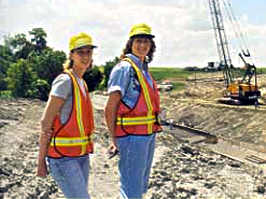 |
|
Sarah
Caliguire (left), St. Cloud State University Seeds student working for
Mn/DOT District 3 Public Affairs in St. Cloud, and Cathy Clark, District
3 Public Affairs, visited the reconstruction of Hwy 12 near Howard Lake
in Wright County field last summer. The Seeds program encourages site
visits to learn about the various types of road work. Photo by Mike
Travis
|
Seeds program grows employees
These education outreach programs have a side benefit for Mn/DOT: they can
enlarge the pool of qualified applicants for Mn/DOT’s technology positions.
"It’s all part of ‘targeted early recruitment’ by Mn/DOT," said
Emma Corrie, Seeds program
manager, adding that she thinks this continuum of programs is beginning to affect
Mn/DOT’s recruitment pool.
"In recent years, we’re seeing a lot more qualified minority applicants
in the colleges and technical schools," she said.
Seeds began in 1994 under the inspiration of former Mn/DOT employee Ike McCrary
and former Commissioner Jim Denn. From minority or economically disadvantaged
backgrounds, Seeds students attend school full-time while working part-time
at Mn/DOT.
"Although some students want to work 40 hours and still go to school,
the program emphasizes school first," Corrie said. "We bring in qualified
students, nurture their potential, expect good grades and performance, provide
training and mentoring, and finally upon graduation, we can transition into
permanent placement."
|



